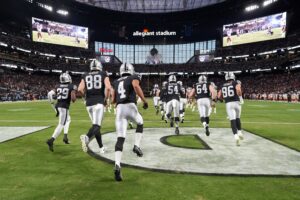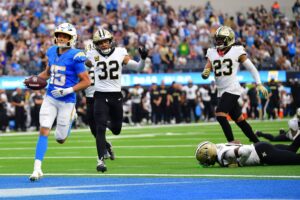Overview
Position: Running back/tight end
Height: 5’11”
Weight: 225 pounds
School: N.C. State Wolfpack
Combine Performance
40-yard dash: 4.54 seconds (tied for best among tight ends)
Bench press: 18 reps
Vertical jump: 34.5 inches (fourth among tight ends)
Broad jump: 10 feet, 1 inch (third among tight ends)
Three-cone drill: 6.93 seconds (second among tight ends)
20-yard shuttle: 4.28 seconds (fifth among tight ends)
Jaylen Samuels 2018 NFL Draft Profile
The tight end position has become one of the most peculiar and unique in all of college football. However, peculiar doesn’t even begin to adequately describe Jaylen Samuels as a prospect. What is he? Is he a tight end? Is he a running back? Could he be a fullback? Wait, did he just play slot receiver for half of that offensive drive?
The answer is yes. Samuels was all of those things for North Carolina State at some point. However, during the NFL Combine he ran with the tight ends. So does that mean he’ll likely play tight end in the NFL? That answer is definite no.
Samuels was a solid four inches shorter and 20 pounds lighter than any other tight end at the NFL Combine this year. Plus, there are exactly zero tight ends in the NFL shorter than six feet tall. It’s clear that Samuels profiles more like an NFL running back than he does a tight end. And that shouldn’t surprise anyone that watched Jaylen Samuels play in N.C. State’s strange offensive scheme.
Samuels’ statistical profile paints a very interesting picture. In his final season, even though he only ran the ball 78 times, he scored 12 rushing touchdowns. At 5’11”, 225 pounds, Samuels clearly had the size and the nose to find the end zone. But then he also caught 75 passes. How did that happen? Well, when he wasn’t carrying the ball as the N.C. State running back, he was still almost always on the field. Samuels lined up as an in-line tight end, H-back (to block and receive), fullback, and even slot wide receiver from time to time. He was an absolute match-up nightmare.
If the right team takes advantage of Samuels’ skill set he could essentially create a new position for the modern NFL. But why would an NFL team bother to do that? Think of it this way. The most common personnel packages run by NFL offenses are 11, 12, and 21 (about 85% of total snaps). Thanks to Samuels’ versatility an offense could run any one of those packages without any substitutions. Defenses wouldn’t know whether to be in a sub-package or base defense. It would be perfect for creating ideal mismatches.
Strengths
- Versatility as both a runner and receiver in a variety of positions;
- Offensive personnel package flexibility;
- Incredible mind to understand offensive scheme and assignment complexities;
- Solid running technique to gain critical yardage before and after contact;
- Above average athleticism as both a running back and tight end.
Weaknesses
- Some NFL teams may not like his tweener skill set;
- Struggles as both a run and pass blocker in many cases;
- Not exactly a home run threat as a running back;
- Not big enough to play in-line tight end every down;
- Doesn’t boast elite elusiveness as a receiver or runner.
NFL Comparison: Larry Centers
Teams With Need at Position: Carolina Panthers, Washington Redskins, Denver Broncos, Baltimore Ravens, Miami Dolphins, New York Jets, Indianapolis Colts, Seattle Seahawks, Detroit Lions, Houston Texans
Projection: Late third to end of the fourth round
Bottom Line
Samuels doesn’t really have a good current NFL comparison. However, that doesn’t mean he won’t find success. If a team wants him to be their lead running back, he could do it. If a team wants him to play part-time as a change-of-pace or goal line back, he could do that too. But in a perfect world, Samuels will land in a spot that allows him to be a little bit of everything. And if Samuels is utilized properly in that do-everything role other NFL offenses could follow suit and the league may never be the same.






